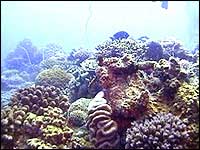 |
| Providing both
food and shelter for marine life, coral is a vital ecosystem |
Imagine if, last year, most of the world's forests died. Well, underwater,
they may have. 1998 was a disaster for coral reefs -- the rain forests
of the ocean -- around the globe. These hugely productive and diverse ecosystems,
which provide habitat to a staggering 25 per cent of marine life, die when
water temperatures rise. Unfortunately, last year temperatures were up
-- prompting scientists to call for immediate environmental action to save
the reefs before it's too late.
But while the situation is dire, an ingenious technique for regenerating
coral -- by using electricity to suck stone out of water -- could help.
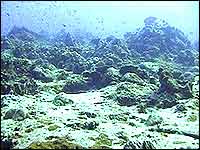 |
| Coral reefs --
like these off Zanzibar -- are dying from the heat |
Called mineral accretion, it was first designed by architect Wolf
Hilbertz as a way of creating new construction materials. But it was soon
transformed into a life-saving system for coral reefs by a scientist intent
on stopping coral devastation before it's too late.
"The method creates conditions that make coral grow at least four times
as fast," says Dr. Thomas Goreau, president of the Global Coral Reef Alliance
and co-creator of the mineral accretion method. "It is the only technology
in the world that can grow corals and build effective erosion barriers
for coastlines."
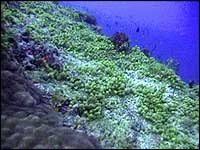 |
| Dead coral becomes
covered by "bad" algae -- that squeeze out new coral |
To understand why mineral accretion works -- and why it's vital to coral
survival -- it's important to understand what coral is, and why it is threatened.
Coral reefs are created by tiny organisms -- coral polyps -- that produce
calcium carbonate (limestone) structures as their exoskeleton. In a beautifully
symbiotic relationship, the polyps depend on microscopic algae that live
on the reefs they build, for nutrients. The result is a living structure
that provides both food and shelter to fish and invertebrates in shallow
tropical waters. They also protect land from erosion, and when parts of
the reef break off and wash up on land, it produces the white sand beaches
people love.
But when ocean temperatures rise, the microscopic algae die -- leading
the coral to "bleach", a sign of starvation.
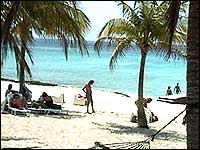 |
| Coral reefs create
and protect the white sandy beaches tourists love |
"When the temperature is even one degree above what they're used to, they
shut down," Goreau says. "The coral expels them. The algae give coral --
which is actually transparent -- its color, so with no algae it looks
white. It means the coral is starving."
Once the coral starve to death, algae return to cover the limestone
skeleton -- but it's the wrong kind of algae. Because coastal waters are
so polluted, they nurture the growth of what Goreau calls "weed algae."
"Coral and microscopic algae are [accustomed to] low-nutrient environment,"
Goreau explains. "Sewage provides excessive nutrients that bring useless,
soft, fleshy fast-growing algae that doesn't provide much fish habitat.
These weeds cover the limestone where coral larvae would settle."
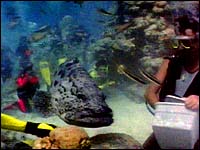 |
| Three quarters
of the world's coral reefs have been affected by the too-warm oceans of
1998 |
That's where mineral accretion comes in. The technology consists of a wire
frame holding electrodes which shoot low voltage electrical currents into
the water. This causes dissolved minerals -- including limestone -- to
crystallize.
"The limestone 'precipitates' out," Goreau explains. "It creates underwater
limestone structures around the wire frame. Then we can either transfer
coral onto the structure or let the larvae settle on it."
And unlike artificial reefs made from junk metal or concrete, this skeleton
doesn't rust or crumble, but only gets stronger with age -- and lets coral
expend all its energy growing.
"The coral we grew in the Caribbean were growing ten centimeters in
ten weeks," Goreau says. "It usually takes a year for that species to do
that."
And according to Goreau, putting the technology in place is critical
if we want any regrowth of the world's coral reefs -- 75 per cent of which
were adversely affected by last year's tropical heat wave.
"This is an emergency," Goreau says bluntly. "Last year, heatstroke
killed more coral than any previous human action. It's the greatest environmental
disaster ever."
The U.S. State Department likely would agree. A report presented to
the U.S. Coral Reef Task Force conference in Maui indicated that coral
reefs have "suffered the most extensive and severe bleaching and subsequent
mortality in modern record" due to warmer ocean temperatures.
The problem, Goreau says, is that immediate global action is needed
to stop climate change and restore the coral -- but because the problem
is under water, people don't have to face it.
"Coral loss would mean lost fisheries, lost tourism, eroded land," Goreau
points out. "The only real solution is to stop global warming cold and
begin restoration programs. But policy-makers aren't diving --so they don't
see it."
To find out more about mineral accretion and coral bleaching visit
the Global Coral Reef Alliance website: http://globalcoral.org
|
